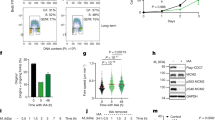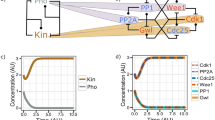Abstract
A novel approach to the study of the control of the mammalian cell cycle was opened by the cloning of a human gene by complementation of a fission-yeast cdc2 cell-cycle mutant1. We have investigated the behaviour of the RNA and protein products of this human gene, CDC2Hs, and its murine equivalent, CDC2Mm during serum starvation and re-feeding of cultured fibroblasts. In contrast to the pattern of wild-type cdc2+ expression in fission yeast previously described2,3, the mammalian homologue displays variation in both RNA and protein levels during exit from and re-entry into the mitotic cycle. Like its yeast counterpart, however, the mammalian CDC2 protein (p34CDC2) becomes dephosphorylated upon shifting from exponential growth to quiescence, and rephosphorylated late in the Gl phase when cells are stimulated to re-enter the cycle. We propose that phosphorylation of p34CDC2 serves as a regulatory mechanism generally in eukaryotic cells, while transcriptional control of the CDC2 gene in higher eukaryotes may be relevant to long term processes such as senescence and differentiation.
This is a preview of subscription content, access via your institution
Access options
Subscribe to this journal
Receive 51 print issues and online access
$199.00 per year
only $3.90 per issue
Buy this article
- Purchase on Springer Link
- Instant access to full article PDF
Prices may be subject to local taxes which are calculated during checkout
Similar content being viewed by others
References
Lee, M. G. & Nurse, P. Nature 327, 31–35 (1987).
Durkacz, B., Carr, A. & Nurse, P. EMBO J. 5, 369–373 (1986).
Simanis, V. & Nurse, P. Cell 45, 261–268 (1986).
Nurse, P. & Bissett Y. Nature 292, 558–560 (1981).
Reed, S. I., Hadwiger, J. A. & Lorincz, A. T. Proc. natn. Acad. Sci. U.S.A. 82, 4055–4059 (1985).
Draetta, G., Brizuela, L., Potashkin, J. & Beach, D. Cell 50, 319–325 (1987).
Pardee, A. B., Dunbrow, R., Hamlin, J. L. & Kletzien, R. F. A. Rev. Biochem. 47, 715–750 (1978).
Zetterberg, A. & Larsson, O. Proc. natn. Acad. Sci. U.S.A. 82, 5365–5369 (1985).
Pledger, W., Stiles, C., Antoiades, H. & Scher, C. Proc. natn. Acad. Sci. U.S.A. 75, 2839–2843 (1978).
Das, M. Proc. natn. Acad. Sci. U.S.A. 78, 5677–5681 (1981).
Campisi, J. & Pardee, A. Molec. cell. Biol. 4, 1807–1814 (1984).
Taylor-Papadimitriou, J., Shearer, M., Balkwill, F. R. & Fantes, K. H. J. Interferon Res. 2, 479–491 (1982).
Coppock, D. L. & Pardee, A. B. Molec. cell. Biol. 7, 2925–2932 (1987).
Holley, R. S. Nature 258, 478–480 (1975).
Rozengurt, E. Curr. Topics cell Regul. 17, 59–88 (1980).
Todaro, G. J. & Green, H. Virology 23, 117–119 (1964).
Author information
Authors and Affiliations
Rights and permissions
About this article
Cite this article
Lee, M., Norbury, C., Spurr, N. et al. Regulated expression and phosphorylation of a possible mammalian cell-cycle control protein. Nature 333, 676–679 (1988). https://doi.org/10.1038/333676a0
Received:
Accepted:
Issue Date:
DOI: https://doi.org/10.1038/333676a0
This article is cited by
-
A time-varying biased random walk approach to human growth
Scientific Reports (2017)
-
Prediction of functional phosphorylation sites by incorporating evolutionary information
Protein & Cell (2012)
-
Dissection of a complex transcriptional response using genome‐wide transcriptional modelling
Molecular Systems Biology (2009)
-
A cdc2 gene of Petunia hybrida is differentially expressed in leaves, protoplasts and during various cell cycle phases
Plant Molecular Biology (1992)
Comments
By submitting a comment you agree to abide by our Terms and Community Guidelines. If you find something abusive or that does not comply with our terms or guidelines please flag it as inappropriate.



